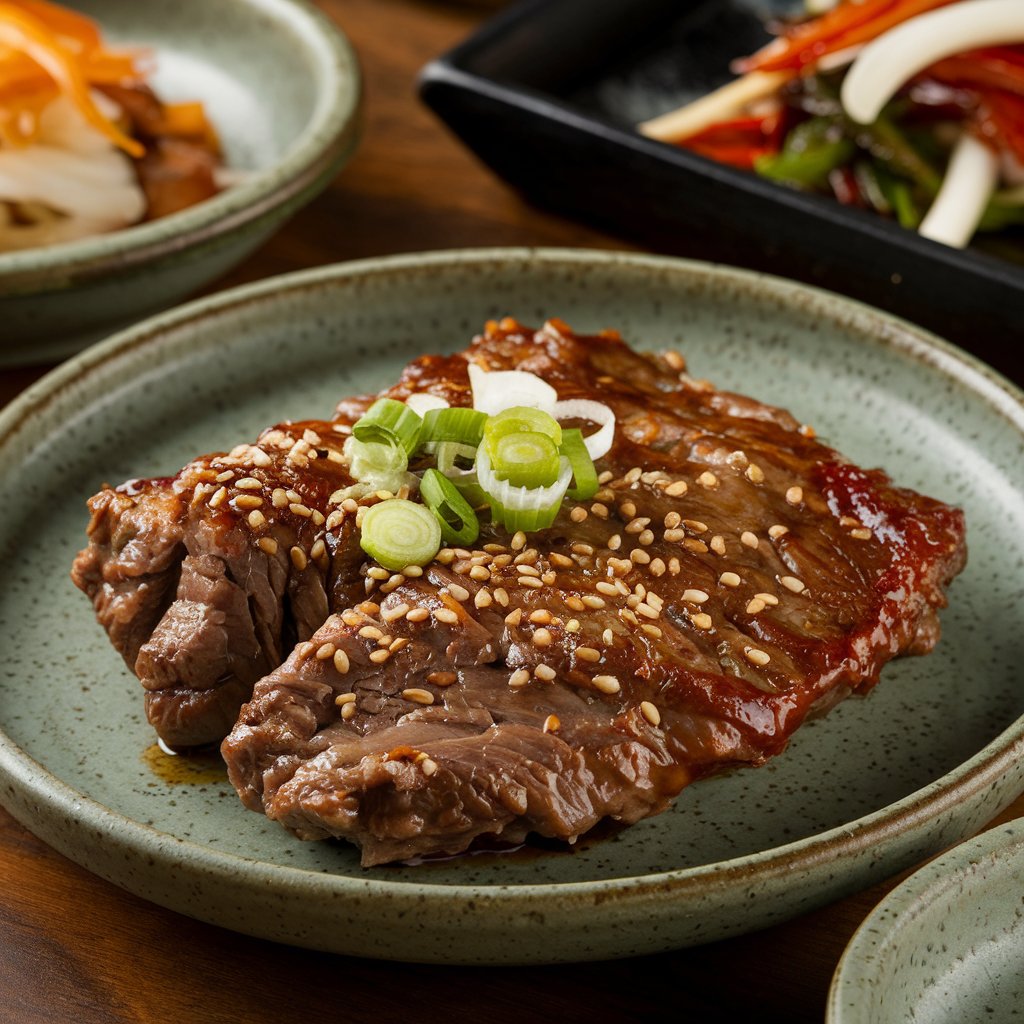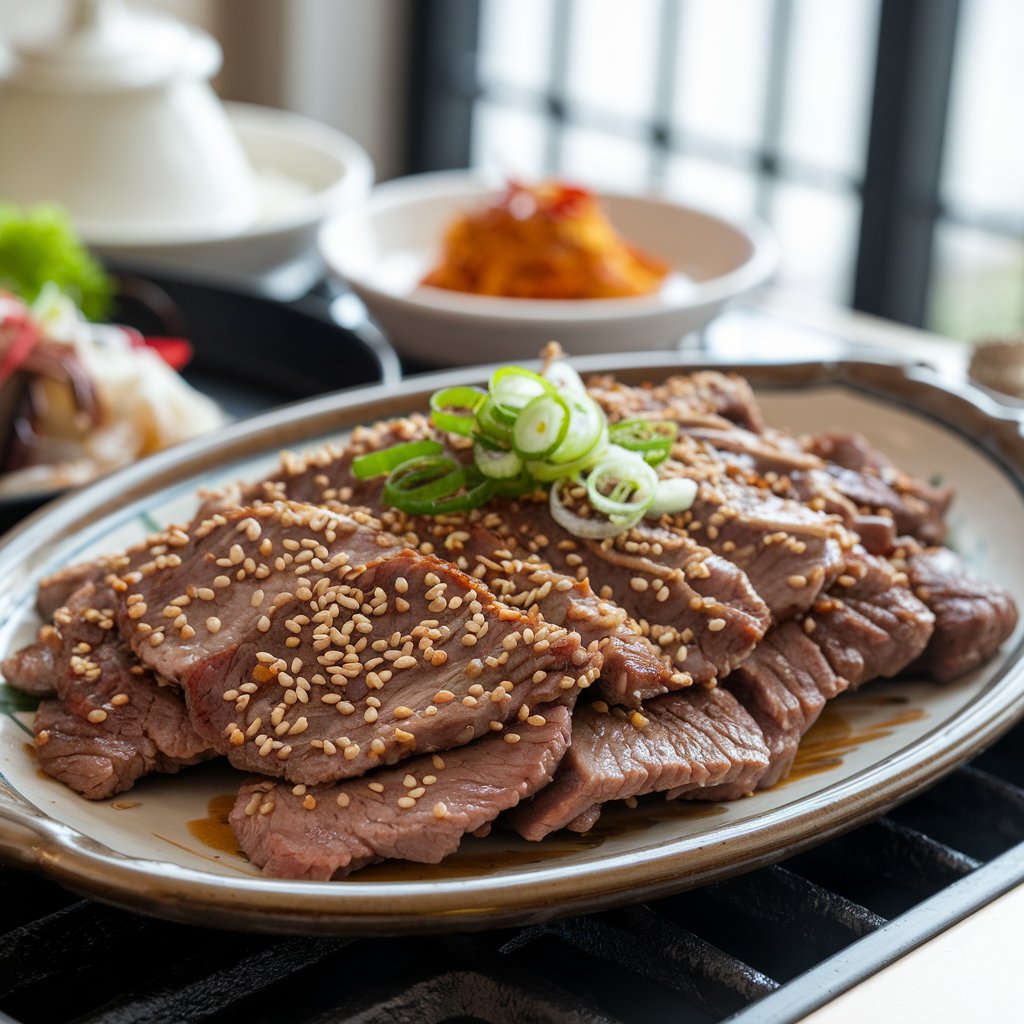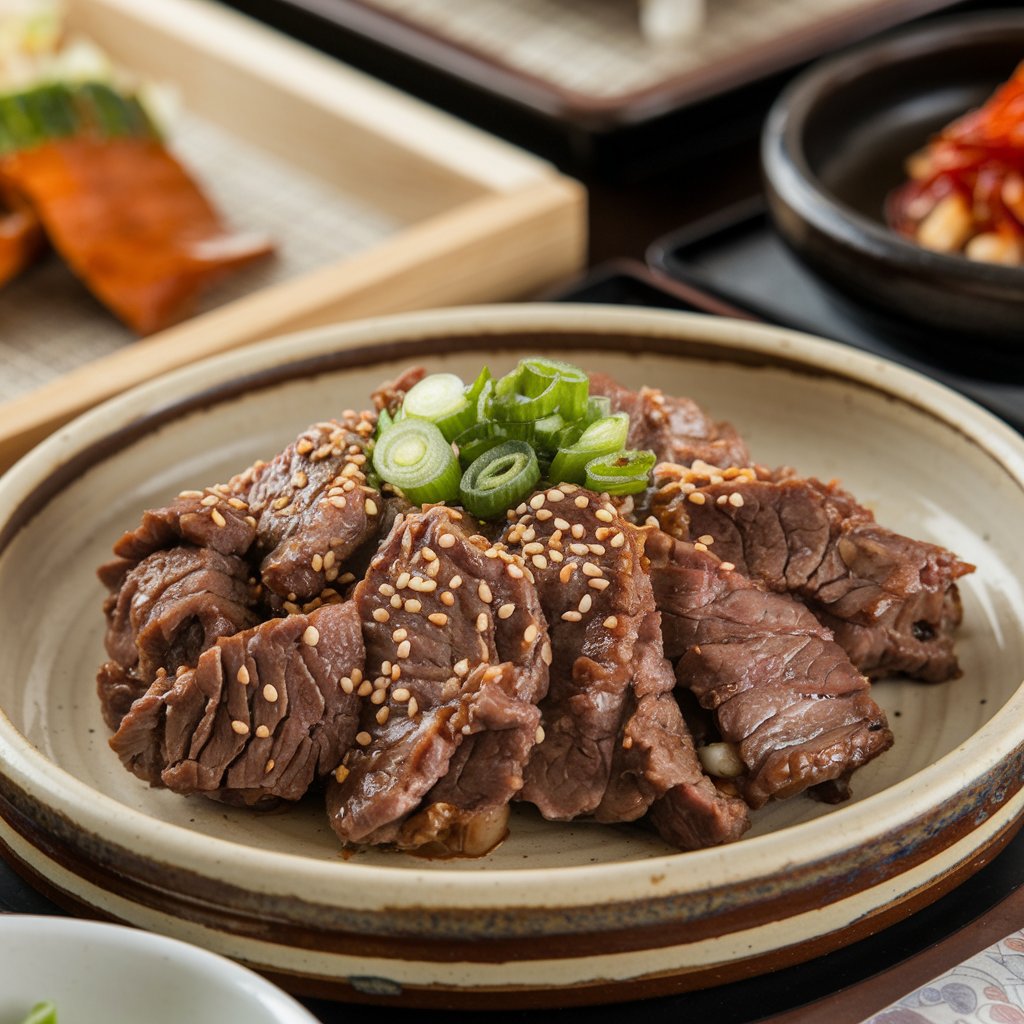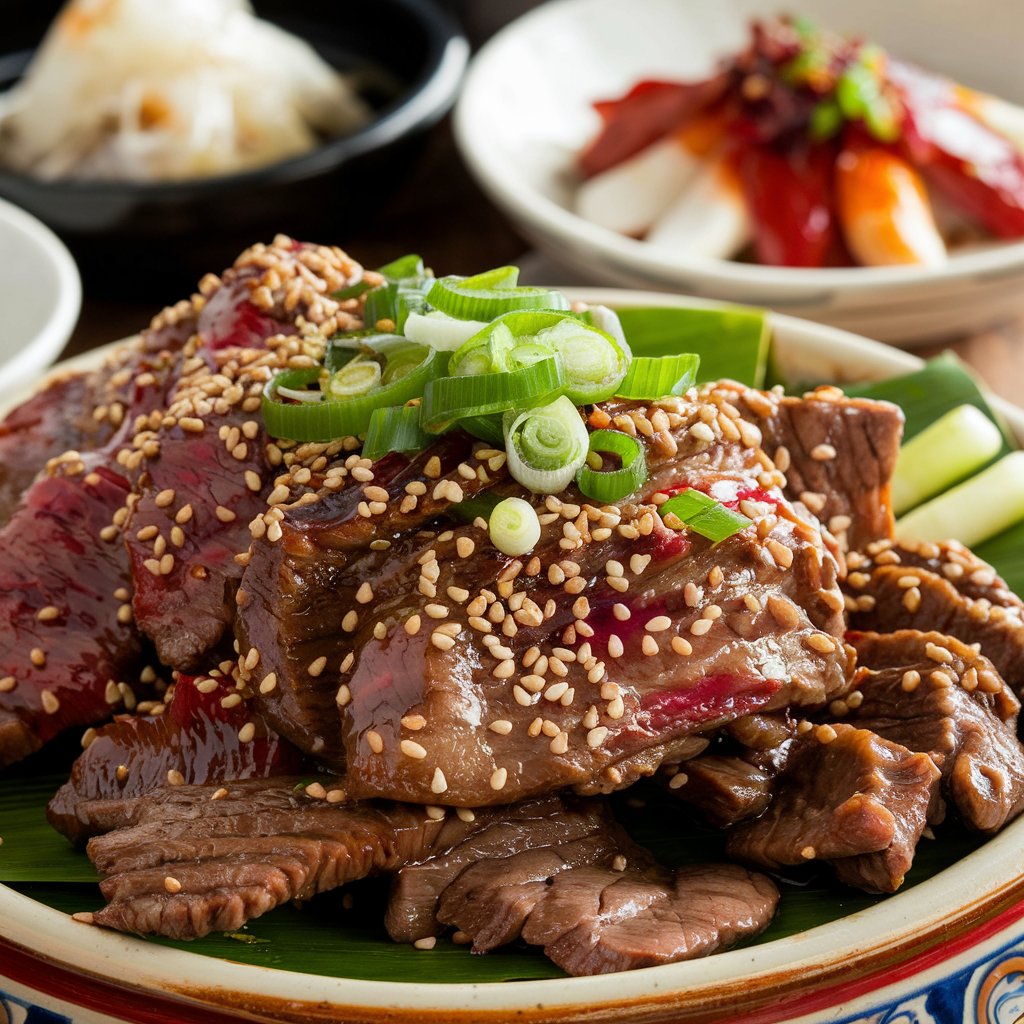If you’ve ever wanted to recreate Korean BBQ at home, this beef bulgogi recipe is exactly what you need. Packed with sweet, savory, and smoky flavors, bulgogi is a classic Korean dish made with thinly sliced beef marinated in a flavorful sauce. This beef bulgogi recipe is easy to follow and perfect for serving over rice, in lettuce wraps, or as part of a Korean-inspired meal.
Beef bulgogi is a culinary masterpiece that brings the heart of Korean barbecue straight to your kitchen. Imagine tender slices of beef marinated in a savory, slightly sweet sauce, cooked to perfection. Sounds good, doesn’t it? Whether you’re a seasoned cook or new to Korean cuisine, this dish is a crowd-pleaser that’s surprisingly easy to master.
Table of Contents
Introduction
Korean cuisine has taken the world by storm, and beef bulgogi is undeniably one of its shining stars. This dish, translating to “fire meat,” combines simplicity and depth of flavor in every bite. Whether enjoyed as a standalone dish, with rice, or wrapped in lettuce leaves, it’s a versatile recipe that deserves a spot on your dinner rotation.
In this guide, we’ll walk through everything you need to know—from selecting the perfect cut of beef to nailing the marinade and exploring creative serving ideas. By the end, you’ll feel confident recreating this classic Korean dish at home.
What is Beef Bulgogi?
- Ground Beef Bulgogi Recipe
- Korean Beef Recipe
- Top Round Steaks
- beef bulgogi recipe
Why is Beef Bulgogi Popular?
Beef bulgogi’s popularity lies in its balance of flavors: a blend of soy sauce, sugar, sesame oil, garlic, and ginger, creating a marinade that transforms beef into a tender, flavorful delicacy. Plus, it’s quick to prepare and pairs wonderfully with an array of sides.

Ingredients for Authentic Beef Bulgogi
Every great recipe begins with great ingredients, and beef bulgogi is no exception. The beauty of this dish lies in its simplicity—each ingredient plays a key role in building the dish’s signature flavor profile.
Essential Ingredients
- Beef:
The foundation of bulgogi. The most commonly used cut is ribeye or sirloin due to their tenderness and marbling. These cuts soak up the marinade beautifully while staying juicy during cooking.Pro Tip: If you’re on a budget, you can opt for thinly sliced flank steak or brisket. Just make sure to cut against the grain for a tender bite. - Soy Sauce:
This umami-packed liquid is the backbone of the marinade, providing a salty and rich flavor. - Sugar or Honey:
Sweetness balances the savory elements and caramelizes beautifully during cooking. - Sesame Oil:
This aromatic oil adds a nutty finish, enhancing the depth of the dish. - Garlic and Ginger:
These aromatics pack a punch, infusing the marinade with warmth and spice. - Pear or Apple:
This might surprise you! Grated Asian pear or apple acts as a natural tenderizer and adds a subtle sweetness. - Green Onions and Sesame Seeds:
These are used for garnish, adding freshness and texture to the final dish.
Beef Selection: Best Cuts to Use
For the ultimate bulgogi experience, thinly sliced ribeye is ideal. The marbling ensures the beef remains moist and flavorful. If you can’t find pre-sliced beef, partially freeze your meat for 20 minutes before slicing it paper-thin with a sharp knife. This little hack makes preparation a breeze.
The Perfect Marinade: A Breakdown
The marinade is the star of the show in beef bulgogi. Here’s a breakdown of the proportions for an authentic marinade:
- Soy Sauce: 1/4 cup
- Sugar: 2 tablespoons
- Sesame Oil: 2 tablespoons
- Grated Pear or Apple: 1/4 cup
- Minced Garlic: 2 teaspoons
- Minced Ginger: 1 teaspoon
Simply whisk these ingredients together until well combined. If you like a spicy kick, add a teaspoon of gochujang (Korean chili paste) or red pepper flakes. 🎉

Optional Ingredients for Personalization
While the classic recipe is incredible on its own, you can experiment to match your taste:
- Sliced Mushrooms: Add earthy notes and a meaty texture.
- Carrots or Zucchini: Thinly sliced vegetables cook quickly and blend well with the marinade.
- Chili Paste or Hot Sauce: Perfect for those who love extra heat!
Step-by-Step Guide to Making Beef Bulgogi
Let’s roll up our sleeves and dive into the process. Making beef bulgogi at home is easier than you might think!
Preparing the Ingredients
Slicing the Beef Thinly
Thin slices are non-negotiable for authentic bulgogi. As mentioned earlier, partially freezing the meat helps you achieve the perfect cut. Place the beef in the freezer for 15–20 minutes, then slice against the grain to ensure tenderness.
Mixing the Marinade
In a large bowl, combine all marinade ingredients. Taste it! Adjust the sweetness or saltiness to your preference before adding the beef.
Marinating the Beef
How Long Should You Marinate?
For optimal flavor, marinate the beef for at least 30 minutes, though overnight in the refrigerator is even better. The longer the beef soaks, the more flavorful and tender it becomes. If you’re short on time, 15 minutes will still work in a pinch.
Cooking Beef Bulgogi
Pan-Frying vs. Grilling
- Pan-Frying: Heat a non-stick skillet or cast-iron pan over medium-high heat. Add a splash of oil and cook the beef in batches, ensuring not to overcrowd the pan.
- Grilling: For an authentic smoky flavor, grill the beef over medium heat, flipping occasionally until fully cooked.
Tips for Perfectly Cooked Bulgogi
- Use high heat to caramelize the marinade’s sugar for that irresistible char.
- Avoid stirring too much; let the beef sear for a few seconds before flipping.
- Drain excess marinade before cooking to prevent steaming instead of searing.

Serving Suggestions and Pairings
Once your beef bulgogi is cooked to perfection, the fun part begins—serving it! Beef bulgogi is incredibly versatile and pairs beautifully with various sides and accompaniments.
Traditional Korean Side Dishes (Banchan)
Korean meals are incomplete without banchan, small side dishes that complement the main course. Here are some popular options to serve with bulgogi:
- Kimchi: Spicy, fermented cabbage adds a tangy kick that balances the sweetness of bulgogi.
- Japchae: Stir-fried glass noodles with vegetables create a hearty side.
- Pickled Radishes: A refreshing, crunchy contrast to the rich beef.
- Bean Sprout Salad: Lightly seasoned sprouts offer a nutty and crisp texture.
Serving Beef Bulgogi Over Rice or Noodles
- Steamed Rice: A classic pairing, rice soaks up the flavorful juices from the beef. White rice is traditional, but brown rice or quinoa works for a healthier twist.
- Noodles: Serve over udon or rice noodles for a fun, slurpable option.
Creative Serving Ideas
If you’re feeling adventurous, try these serving ideas:
- Lettuce Wraps: Use fresh lettuce leaves as wraps, adding sliced garlic, chili, and a dollop of ssamjang (fermented soybean paste) for an authentic Korean BBQ experience.
- Tacos: Fill soft tortillas with bulgogi, slaw, and a drizzle of spicy mayo for a fusion dish.
- Bowls: Build a bulgogi bowl with rice, sautéed vegetables, and a sunny-side-up egg for a complete meal.
Block Quote: “Bulgogi’s versatility makes it a culinary canvas. Whether you stick to tradition or explore fusion options, it’s guaranteed to be a hit!”
Common Problems and Their Solutions
Even with the best intentions, a few hiccups can arise while making beef bulgogi. Here’s how to troubleshoot common issues:
Beef Turning Tough: How to Avoid It
The culprit behind tough bulgogi is often overcooking or incorrect slicing. Here’s how to fix it:
- Slice Against the Grain: Cutting the beef against the grain shortens muscle fibers, making it tender.
- Cook Quickly Over High Heat: Bulgogi should cook fast to avoid drying out.
Balancing Flavors in the Marinade
Too salty? Too sweet? Adjusting the marinade is key to nailing the perfect flavor:
- Add a splash of water or grated pear to reduce saltiness.
- Incorporate more soy sauce or sugar if the flavor is too mild.
Cooking Without a Grill: Alternative Methods
Don’t have a grill? No problem!
- Use a cast-iron skillet for a rich sear.
- Try a broiler to replicate the high heat of a grill.
Block Quote: “The beauty of bulgogi lies in its adaptability—you can cook it just about anywhere!”
Health Benefits of Beef Bulgogi
Beef bulgogi is not just delicious; it’s also packed with nutrients when made thoughtfully.
Nutritional Highlights
- Protein-Packed: Lean cuts of beef provide essential amino acids that support muscle growth and repair.
- Rich in Vitamins and Minerals: Bulgogi marinade ingredients like garlic and ginger offer antioxidants and anti-inflammatory properties.
- Low in Saturated Fat: Opt for leaner cuts or drain excess marinade to keep the dish heart-healthy.
Tips for Making a Healthier Bulgogi
Want to enjoy bulgogi guilt-free? Try these swaps:
- Use low-sodium soy sauce to reduce sodium content.
- Replace sugar with natural sweeteners like honey or stevia.
- Add more vegetables to bulk up the dish and lower calorie density.
Frequently Asked Questions (FAQs)
Here are some common questions about making and enjoying beef bulgogi.
Can I Use Other Types of Meat for Bulgogi?
Absolutely! While beef is the classic choice, you can use chicken, pork, or even tofu for a vegetarian option. Adjust the cooking time accordingly.
How Do I Store Leftover Beef Bulgogi?
Store leftovers in an airtight container in the refrigerator for up to three days. Reheat in a skillet over medium heat to retain its flavor and texture.
Can I Make Beef Bulgogi in Advance?
Yes! You can marinate the beef up to 24 hours in advance. This allows the flavors to deepen, making the dish even more delicious when cooked.
Conclusion
Beef bulgogi is a delightful dish that brings the flavors of Korean cuisine to your table with minimal effort. Its tender beef, savory-sweet marinade, and versatility make it a must-try for anyone who loves a good barbecue. Whether you stick to traditional pairings or get creative with serving ideas, this recipe is sure to impress.

